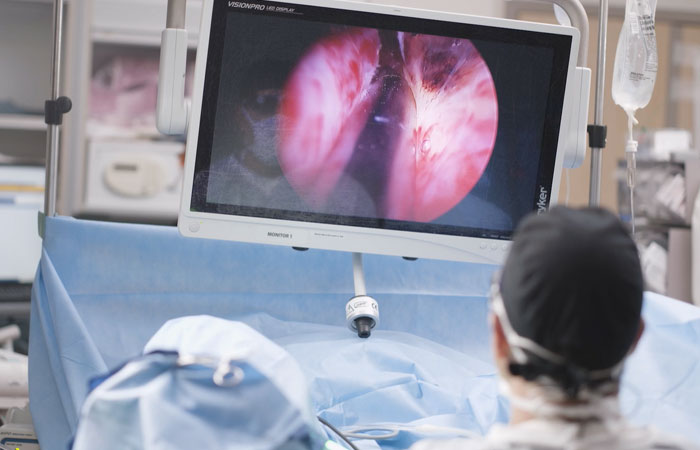
Ricardo R. Gonzalez, M.D.
Associate Professor of Urology, Houston Methodist Hospital, and Adjunct Associate Professor of Urology, Texas A&M College of Medicine
Editorial commentary
Sexual activity can remain an essential component of overall quality of life and therefore, physicians should address each patient’s goals when undergoing BPH treatment.1 Physicians should speak to patients directly about the patient's sexual function, whether or not they are sexually active and what their expectations are after treatment. Often those patients who are still sexually active may be interested in preserving their erectile and ejaculatory functions. If so, physicians may offer different treatments or treatment approaches that are less likely to harm that function as there have been many advancements in BPH treatments to preserve ejaculatory function.2
One BPH treatment modification is the ejaculatory hood-sparing technique.3
The potential benefits and risks of ejaculatory hood-sparing technique
Some patients undergoing laser prostate surgery who are interested in preserving ejaculation may be viable candidates for the ejaculatory hood-sparing approach.4
A potential drawback is that there is a slightly higher chance that the patient will need retreatment.4 The current retreatment rate with standard GreenLight™ Laser Therapy, not using the hood-sparing technique, is 1.5%.5 I anticipate it may be higher with an ejaculatory hood-sparing approach.4 But longer-term studies are needed to determine what the actual risk is over time.
Preliminary research shows that men undergoing this treatment modality may be able to preserve ejaculation.6 In a feasibility study of 27 participants, results at 6 months show that when using the technique for patients with lateral lobe and middle lobe obstruction, the ejaculatory preservation rate with this modification was 78–85%.6
My procedure approach
Before starting the procedure, I suggest that urologists talk to their patient, namely describing treatment that may preserve the ejaculation. They should aim to develop a strategy based upon the anatomy of the prostate and the patient’s goals. For example, if you are treating more than one lobe, which one are you going to do first? This is especially important if the patient wants the opportunity to preserve ejaculation.
My goal for the ejaculatory hood-sparing technique using standard photo-selective vaporization (PVP) or PVP Vaporization Incision Technique (VIT) is to preserve the tissue 1 cm proximal to the verumontanum (seminal colliculus) and along the pericollicular sulci.
Step by step
- Marking the anatomy — During the procedure, remain conscious of landmarks and anatomy. I make laser markings on the anatomy, even though I will later remove that tissue. When working from the bladder neck distally, you come to where the middle lobe cascades down, stop at least a centimeter proximal to the verumontanum. Take the width of the verumontanum visually, then mark the lateral lobe with the laser at least a centimeter up from the verumontanum. You are creating a protected zone that resembles the Eiffel Tower. In this way, when you're making that incision working backwards, you don't accidentally cut into the duct structure.
- Making the incisions — If you start on one of the lateral lobes (I usually start with the left lobe), make a 5 o’clock incision. Then make an incision at 7 o’clock. When you undermine the lateral lobe, mark it so you work away from the sphincter. Work inward to drop the mucosa, marking that mucosal incision in low energy (from 80 to 120 watts). Then increase the energy and develop a groove so that it merges onto that 5 o’clock plane. Work laterally under that lateral lobe.
- Vaporizing — Come above the lobe to make an incision at 1 o’clock and vaporize the tissue between the 1 o’clock and 5 o’clock grooves. Distally by the apex, stay above 3 o’clock, and preserve that mucosal flap, the marker to stay away from the ejaculatory duct structures.
- Merging the incisions — Mark the distal limit at 3 o’clock and 9 o’clock with coagulation. Start in a retrograde manner, vaporizing at 3 o’clock, which drops a piece of mucosa down and exposes the adenoma or the gland. Vaporize and widen that area. Starting too close may lead to thermal injury of the tissue you're trying to preserve, so start a little more anterior than usual. Merge that incision into the 5 o’clock incision, working from the bladder neck back, and follow that laterally, following the capsule under that lateral lobe.
- Lasering the middle lobe — Then do the middle lobe, lasering it just as if you were not doing the hood-sparing technique except to stop short of a one-centimeter protected zone, the “Eiffel Tower.” In other words, while you're doing the middle lobe, stay proximal — to the bladder side — of the verumontanum.
- Repeat — Repeat these steps on the contralateral side. With the 7 o’clock incision in place, go to 9 o’clock at the apex, mark the distal limit. Then work inwards to drop that mucosal flap to create the ejaculatory hood and preserve the ejaculatory ducts. Then work laterally under that lateral lobe. Make an incision at 11 o’clock, come down behind it either to do the VIT technique, or you enucleate the lobe in its entirety. And then you can use high power to smooth out anything that needs smoothing.
- Catheterization — Respecting the “Eiffel Tower,” extract or morcellate any tissue that you have in the bladder. It is alright to leave bleeders close to the verumontanum. Do not cauterize too much there — limit thermal spread. The bleeding usually stops with use of the catheter. After inserting the catheter, a patient typically leaves it in one night and then it is removed the next morning at home.
Conclusion
I’ve seen success in my practice preserving ejaculatory function in my patients with the ejaculatory hood-sparing technique. Sexual activity remains an essential component of overall quality of life and preliminary studies are encouraging.1,6 That’s why I think urologists should learn these modifications so that they can offer this as an option for their patients who are undergoing surgery for BPH. As a start, there are technique spotlights available on PVP and VIT.
Related content
References
- Calais Da Silva F, Marquis P, Deschaseaux P, Gineste JL, Cauquil J, Patrick DL. Relative important of sexuality and quality of life in patients with prostatic symptoms: results of an international study. Eur Urol. 1997;31:272–280.
- Leong JY, Patel AS, Ramasamy R. Minimizing sexual dysfunction in BPH surgery. Curr Sex Health Rep. 2019; 11:190–200.
- Brant A, Cho A, Posada Calderon L, Te A, Kashanian J, Chughtai B. Ejaculatory hood-sparing vaporization of the prostate and its impact on erectile, ejaculatory, and sexual function. Urology. 2020;144:177–181.
- Abolazm AE, El-Hefnawy AS, Laymon M, Shehab-El-Din AB, Elshal AM. Ejaculatory hood sparing versus standard laser photoselective vaporization of the prostate: sexual and urodynamic assessment through a double blinded, randomized trial. J Urol. 2020;203:792–801.
- Law KW, Tholomier C, Nguyen D-D, et al. Global Greenlight group: Largest international Greenlight experience for benign prostatic hyperplasia to assess efficacy and safety. World J Urol. 2021;39:4389–4395.
- Kini M, Te AE, Kashanian JA, Kaplan S, Chughtai B. Ejaculatory hood-sparing photoselective vaporization of the prostate vs. bipolar button plasma vaporization of the prostate in the surgical management of benign prostatic hyperplasia. J Endourol. 2020;34:322–329.
Caution: U.S. Federal law restricts this device to sale by or on the order of a physician.
IMPORTANT INFORMATION: These materials are intended to describe common clinical considerations and procedural steps for the use of referenced technologies but may not be appropriate for every patient or case. Decisions surrounding patient care depend on the physician’s professional judgment in consideration of all available information for the individual case.
Boston Scientific (BSC) does not promote or encourage the use of its devices outside their approved labeling. Case studies are not necessarily representative of clinical outcomes in all cases as individual results may vary.
Results from case studies are not necessarily predictive of results in other cases.
Results in other cases may vary.Results from different clinical investigations are not directly comparable. Information provided for educational purposes only.
For information purposes only. The content of this article/publication is under the sole responsibility of its author/publisher and does not represent the opinion of BSC.
Ricardo R. Gonzalez, M.D., is a Boston Scientific consultant and was compensated for his contribution to this article.
All images are the property of Boston Scientific. All trademarks are the property of their respective owners.

